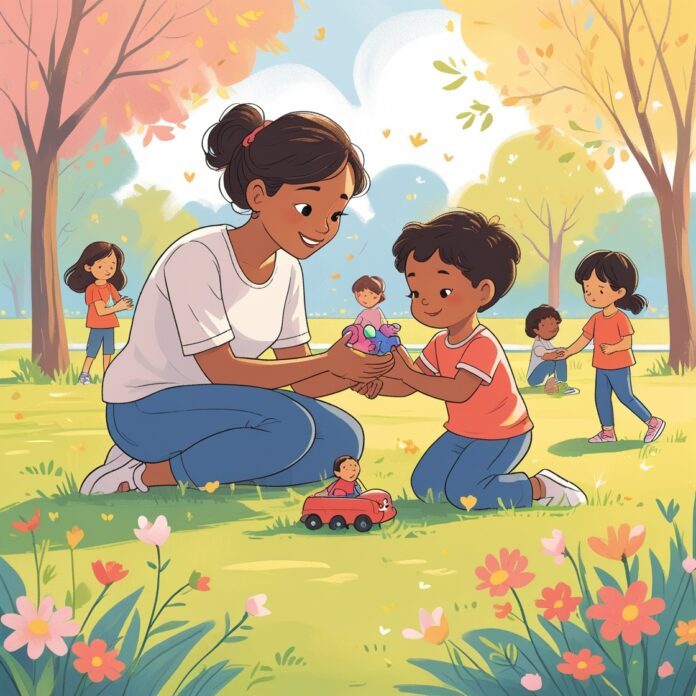Giving guidance to a child who embodies the values of kindness and respect can be a challenging task especially when the world is moving so fast now. Yet, knowing these are the attributes that support good relationships, well-behaved kids, and emotional intelligence, you would agree that they are truly important. Parents through regularly demonstrating the principles of kindness and respect, giving children opportunities to practice, and rewarding positive behavior can effectually develop these traits in their kids.
In this writing, we will discuss the various practices available for parents to make their child respectful and kind, along the way, the significance of patience and consistency here.

The Relevance of Kindness and Respect
Kindness and respect are indispensable elements that not only are they desirous traits, but they are also key to the creation of a compassionate and inclusive society. The kids who are instilled these value sand therefore will be more likely to work in teams, solve their differences without hurting anyone, and show others their feelings. They, as a result, tend to feel at ease emotionally and understand that they have social obligations. Also, the kids who are polite and kind usually don’t participate in such negative behavior as, for example, bullying or aggression.
1. Lead by Example: Show Kindness and Respect in Your Actions
Children are likely to learn from adults, especially their parents, as they are acute observers and imitators. If you want your child to be kind and respectful, you need to be very consistent in the way you behave. That is to say, you must be respectful when dealing with others, have an understanding heart, and display kindness even under testing circumstances.
For example, when you talk to service staff, teachers, or neighbors, show respect by using polite words, being patient, and expressing your gratitude. If you set a good example by showing kindness to others, your child will appreciate the idea of helping without looking for rewards.
One important hint: Practice good language in your household. Laud those small acts of kindness and thank your child for their respect toward others. This positive reinforcement is a way to get the same behavior.
2. Teaching Empathy through Conversations
Empathy is a primary skill for personal relationships, which reflects kindness and respect. Educating your child is one of the most effective ways to foster these values. Your child’s feelings can be related to one of the best practices in teaching lessons about others’ feelings. You can simply start a conversation by asking your child hypothetical questions about other people’s feelings in various situations.
For example, you can say “How do you think your friend felt?” after an unpleasant event with a friend or a sibling. This not only makes your child think about the emotional side of their behavior but also aware of why being kind and respectful to others is so important.
Key tip: You can use stories and books as part of your explanation to teach the importance of empathy. There are a lot of books for children that deal with the power of kindness, such as Have You Filled a Bucket Today? by Carol McCloud, which is about the concept of emotional generosity.

3. Reinforce Positive Behavior with Praise
Children respond to positive comments with a good behavior better. When your child shows a sign of generosity or respect, praise him instantly and specifically for his behavior. Like if your child shares his toys with a sibling, tell him, “I am very proud of how you divided the toy with your sister today, you were very polite.”.
Through specific praise, the child’s behavior is understood, the specific behavior that is desired is recognized. The latter also adds to his self-esteem, and the notion of kindness and respect grows in his mind that is worth seeking after.
Key tip: It is necessary to point out to the child the actions which demonstrate the wanted behavior (e.g. “I noticed how you helped your friend clean up the toys, that was a respectful thing to do”) than to compliment the child’s personality traits (e.g., “You are such a kind person”).
4. Encourage the Practicing of Kindness to Others
Hands-on activities that are the most efficient way to show the kindness concept. Try to engage the child in different acts of kindness, both small and big. This is even as easy as being a kind person by opening the door for someone or it can be as big as working without pay for a charity organization.
Making kindness a family thing can be as simple as arranging a weekly/ monthly schedule for helping the less fortunate. An example is taking the time for a whole family to go and give clothes to a shelter or choosing a day every month to bake cookies for a neighbor in need. The kids will understand that kindness is not only just a trait but it can also be an action expressed in so many different ways.
Main hint: Create a kindness jar in the house. Each time your child shows a kind act you can use a piece of paper to write it down and the jar could be the place where they can add them. When the month ends, you can read them together and this will remind them of the good energy they’ve made.

5. Set Clear Expectations and Boundaries
While it is important to raise and nurture your child in kindness and respect, it is also important to have set boundaries regarding the behavior of the child. The understanding of children about their zones of kindness and respect is of importance as much as how they treat others.
Teach the significance of personal space, good manners, and listening when spoken to. Add to the list the explanation of the bad results of showing signs of disrespect, such as through body language or saying rude words. The kids will be consistent and learn the lesson about not only respecting others’ feelings but also the space by the parents being consistent in drawing lines.
Key tip: Don’t look at it as something bad and in need of being punished; rather, tackle it as an opportunity to talk about the consequences of actions. For example, you can ask your child how they would feel if someone treated them in the way s/he has just treated another.
6. Build a Safe and Supportive Environment
One’s place of living has a significant impact on one’s predisposition to kindness and respect. A supportive family and school environment that fosters good social manners in children is key to the task. It’s common to see that kids who are raised in a secure and respectful environment will practice kindness and be more respectful automatically because these two values are something the kids will accept and expect from the society moving towards the future that we might not see but they will.
It is very important that your child find friends who are like-minded and with whom they can practice these activities. Unscheduled social gatherings or after-school activities are environments in which social skills of children can be sharpened. The safety provided by an environment that acknowledges and values kindness will ensure that children both absorb these traits and act upon them habitually, which will also go a long way in reducing negative interactions with their surrounding environment.
Most important: Share with your child the necessity of stepping up for others, for example, if someone is being bullied, it’s either speaking against the bullying or supporting the friend who is left out. Encouraging children to be kind to their peers not only creates a strong sense of responsibility in them but also helps them develop their personality.

7. The Need for Patience and Consistency
Teaching kindness and respect is not an ad hoc operation. It is a task that requires patience and regularity. Children will sometimes displease us, but it is imperative to correct them gently and reinforce their good actions. At the same time, they start to recognize these and other positive traits and over time they become an integral part of their behavioural patterns. Carefully, gently and lovingly is how to communicate with your child during his growth ensuring that kindness and respect are the core values are not only important but also emphasized as home, school and community are consistently the right places to find them.
Top – Remember that your child’s emotional growth is a gradual process. Appreciate the small wins as you go and be patient with the way in which they progress.
Nurturing your child’s understanding of kindness and respect is a lengthy and never-wasted journey to their emotional and social growth. You can encourage your child’s development of these core life skills via not only by being a role model but also teaching empathy, using positive reinforcement, and providing them with an environment for practice. Loving, being patient and consistent with your children will turn your children into compassionate and respectful individuals who know the importance and can take good care of positive relationships with others.



